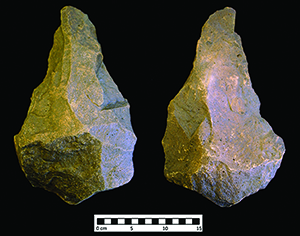Crossref Citations
This article has been cited by the following publications. This list is generated based on data provided by
Crossref.
Scerri, Eleanor M. L.
Shipton, Ceri
Clark-Balzan, Laine
Frouin, Marine
Schwenninger, Jean-Luc
Groucutt, Huw S.
Breeze, Paul S.
Parton, Ash
Blinkhorn, James
Drake, Nick A.
Jennings, Richard
Cuthbertson, Patrick
Omari, Abdulaziz Al
Alsharekh, Abdullah M.
and
Petraglia, Michael D.
2018.
The expansion of later Acheulean hominins into the Arabian Peninsula.
Scientific Reports,
Vol. 8,
Issue. 1,
Barboni, Doris
Ashley, Gail M.
Bourel, Benjamin
Arráiz, Hector
and
Mazur, Jean-Charles
2019.
Springs, palm groves, and the record of early hominins in Africa.
Review of Palaeobotany and Palynology,
Vol. 266,
Issue. ,
p.
23.
Kübler, Simon
King, Geoffrey C. P.
Devès, Maud H.
Inglis, Robyn H.
and
Bailey, Geoff N.
2019.
Geological Setting, Palaeoenvironment and Archaeology of the Red Sea.
p.
653.
Bailey, Geoff N.
Meredith-Williams, Matthew
Alsharekh, Abdullah
and
Hausmann, Niklas
2019.
Geological Setting, Palaeoenvironment and Archaeology of the Red Sea.
p.
583.
Beyin, Amanuel
Chauhan, Parth R.
and
Nassr, Ahmed
2019.
Reconnaissance of Prehistoric Sites in the Red Sea Coastal Region of the Sudan, NE Africa.
Journal of Field Archaeology,
Vol. 44,
Issue. 3,
p.
147.
Inglis, Robyn H.
Fanning, Patricia C.
Stone, Abi
Barfod, Dan N.
Sinclair, Anthony
Chang, Hsing‐Chung
Alsharekh, Abdullah M.
and
Bailey, Geoff
2019.
Paleolithic artifact deposits at Wadi Dabsa, Saudi Arabia: A multiscalar geoarchaeological approach to building an interpretative framework.
Geoarchaeology,
Vol. 34,
Issue. 3,
p.
272.
Sinclair, Anthony
Inglis, Robyn H.
Shuttleworth, Andrew
Foulds, Frederick
and
Alsharekh, Abdullah
2019.
Geological Setting, Palaeoenvironment and Archaeology of the Red Sea.
p.
533.
Beyin, Amanuel
2021.
The Western Periphery of the Red Sea as a Hominin Habitat and Dispersal Corridor: Marginal or Central?.
Journal of World Prehistory,
Vol. 34,
Issue. 3,
p.
279.
Stone, Abi
Inglis, Robyn
Barfod, Dan
Ickert, Ryan
Hughes, Lewis
Waters, John
Jourdan, Anne-Lise
and
Alsharekh, Abdullah M.
2022.
Hydroclimatic and geochemical palaeoenvironmental records within tufa: A cool-water fluvio-lacustrine tufa system in the Wadi Dabsa volcanic setting, western Saudi Arabia.
Sedimentary Geology,
Vol. 437,
Issue. ,
p.
106181.
Barzilai, Omry
Oron, Maya
Cohen-Sasson, Eli
Ragolski, Gideon
and
Avni, Yoav
2023.
Handaxes and Cleavers on Flakes of Silicified Limestone at Nahal Barak, Southern Negev and Possible Connections to the Arabian Peninsula Acheulian.
Paléorient,
p.
9.
Stone, Abi
Inglis, Robyn H.
Candy, Ian
Sahy, Diana
Jourdan, Anne-Lise
Barfod, Dan N.
and
Alsharekh, Abdullah M.
2023.
Humid phases on the southwestern Arabian Peninsula are consistent with the last two interglacials.
Quaternary Science Reviews,
Vol. 319,
Issue. ,
p.
108333.
Walker, Sally E.
2023.
Conservation biology and conservation paleobiology meet the Anthropocene together: history matters.
Frontiers in Earth Science,
Vol. 11,
Issue. ,
Ingrey, Letty
Bates, Martin
Duffy, Sarah
and
Pope, Matt
2023.
A New Palaeolithic Giant Handaxe from Britain: Initial Results from Excavations at Maritime Academy, Medway, Kent.
Internet Archaeology,
Khaksar, Somaye
and
Modarres, Reza
2024.
How good are giant handaxes in utilitarian functions? An experimental assessment.
Journal of Archaeological Science: Reports,
Vol. 53,
Issue. ,
p.
104301.
Dale, Luke
Rawlinson, Aaron
Knowles, Pete
Foulds, Frederick
Ashton, Nick
Bridgland, David
and
White, Mark
2024.
Big enough to matter: on the frequency and chronology of giant handaxes in the British Lower Palaeolithic.
Antiquity,
Vol. 98,
Issue. 398,
p.
305.
